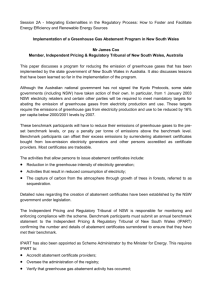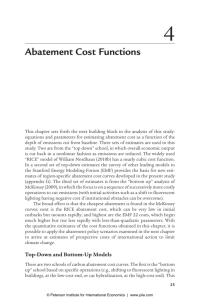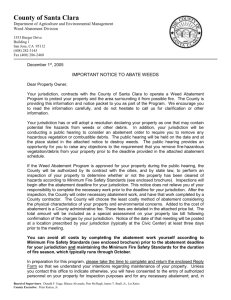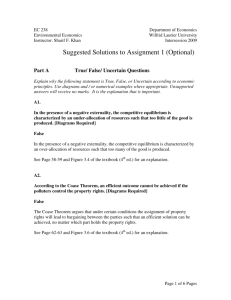A Cost Curve for Greenhouse Gas Reduction
advertisement
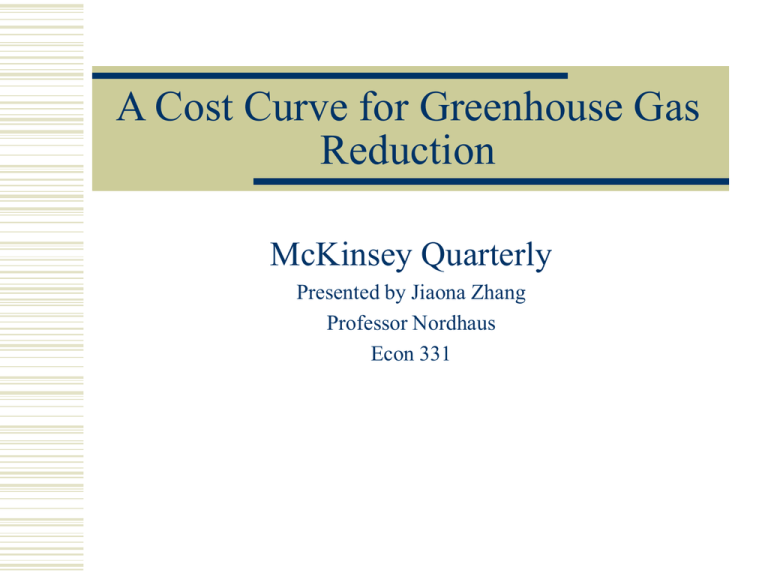
A Cost Curve for Greenhouse Gas Reduction McKinsey Quarterly Presented by Jiaona Zhang Professor Nordhaus Econ 331 Aim of study Not to evaluate the science of climate change Not to say whether countries should act Instead: Cost of each emissions reduction method Implications of regulations First microecon investigation to cover all relevant greenhouse gases, sectors, and regions SECTORS Power generation Manufacturing Transportation Buildings Forestry Agriculture Waste disposal REGIONS North America Western Europe Eastern Europe Other developed countries China Other developing nations Assumptions Future cost Feasible deployment rates Available abatement measures CCS Cost of CCS will fall to 20-30 euros/ton by 2030 85% of coal plants built after 2020 will have this tech Wind actions to abate will have already begun across regions by 2008 Use of existing tech serves to counterbalance “we have been fairly conservative in our assumptions about technological progress in these projections” Example: analysis ignores the potential of concentrated solar thermal electricity entirely Reduction Potential: -assumption for volume growth in BAU scenario -assumption for market uptake dependent on competitiveness, consumer acceptance, industry investment -2nd order impact of the rebound effect? Two ends of the cost curve Low End: measures that improve energy efficiency Better insulation in new buildings lowers demand for power Retrofitting lighting High End: Adopting more greenhouse gas-efficient tech: wind, solar, CCS Replanting tropical forests Switching to agricultural practices with greater greenhouse gas efficiency Insights Forestry/Agriculture Power/Manufacturing Buildings/Transport Capturing lower cost possibilities requires global abatement system Power generation and manufacturing not only focus: transportation, buildings, forestry, agriculture A quarter comes from efficiency enhancing measures Correlation between economic growth and ability to implement low-cost measures to reduce emissions Abatement can come from measures that are independent from tech or based on mature tech http://climateprogress.org/wp-content/uploads/2008/06/mgi-myths.jpg How much would this cost? Cost of the 450ppm scenario depends on the ability to capture all of the available abatement potential that costs up to 40 euros/ton Cost curve indicates that annual worldwide cost would be 500 billion euros in 2030, or 0.6% of yr’s projected GDP With more expensive approaches, cost = as high as 1.1 trillion euros, or 1.4% of global GDP Putting it into perspective “To put this figure in perspective, if one were to view this spending as a form of insurance against potential damage due to climate change, it might be relevant to compare it to global spending on insurance, which was 3.3 percent of GDP in 2005.” http://climateprogress.org/2008/12/29/mckinsey-2008-research-in-review-stabilizing-at-450-ppm-has-a-net-cost-near-zero/ Impact on the economy “Borrowing could potentially finance many of the costs, thereby effectively limiting the impact on near-term GDP growth. In fact, depending on how new low-carbon infrastructure is financed, the transition to a low-carbon economy may increase annual GDP growth in many countries.” http://climateprogress.org/2008/12/29/mckinsey-2008-research-in-review-stabilizing-at-450-ppm-has-a-net-cost-near-zero/ If negative cost, why are we not doing more? Consumers are short-sighted Lack of information Cost of abatement omits other relevant costs for firms Analysis might impose a discount rate that is inconsistent with the trade-offs firms make in practice Methodological critique Assumptions Effects of additional disposable income on future energy demand Rebound effects of energy savings Undesired consequences in the case of lowenergy bulbs Role of technological innovation in driving new sources of demand Bibliography "CERA: Client Services: European Policy Forum: The Cost of Energy Efficiency Investments: The Leading Edge of Carbon Abatement." CERA: Cambridge Energy Research Associates. Web. 05 Apr. 2010. <http://www.cera.com/aspx/cda/client/MCS/MCSChapter.aspx?KID=227&CID=9484>. “A Cost Curve for Greenhouse Gas Reduction,” The McKenzie Quarterly, 2007, 1, pp. 35-45 "The EPA Tackles Greenhouse Gas - Forbes.com." Forbes.com - Business News, Financial News, Stock Market Analysis, Technology & Global Headline News. Web. 05 Apr. 2010. <http://www.forbes.com/2009/12/27/epa-greenhouse-gasclimate-opinions-contributors-ted-gayer.html>. "McKinsey 2008 Research in Review: Stabilizing at 450 Ppm Has a Net Cost near Zero. «." Climate Progress. Web. 05 Apr. 2010. <http://climateprogress.org/2008/12/29/mckinsey-2008-research-in-review-stabilizing-at-450-ppm-has-a-netcost-near-zero/>. “U.S. Greenhouse Gas Abatement Mapping Initiative: Executive Report.” Dec 2007. McKinsey and the Conference Board. <http://www.econ.yale.edu/~nordhaus/homepage/documents/McKinsey_US_ghg_final_report.pdf>.
